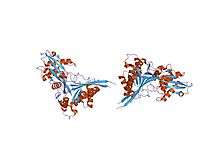XOL-1 Switch protein N-terminal domain
| Xol-1_N | |||||||||
|---|---|---|---|---|---|---|---|---|---|
 crystal structure of xol-1 | |||||||||
| Identifiers | |||||||||
| Symbol | Xol-1_N | ||||||||
| Pfam | PF09108 | ||||||||
| Pfam clan | CL0329 | ||||||||
| InterPro | IPR015192 | ||||||||
| SCOP | 1mg7 | ||||||||
| SUPERFAMILY | 1mg7 | ||||||||
| |||||||||
In molecular biology, Xol-1 is a protein domain, also named the Switch protein, is essentially a sex-determining protein. This entry focuses on the N-terminal domain of Xol-1. Xol-1, the master switch gene controlling sex-determination system and dosage compensation. This protein is normally expressed in males, where it promotes male development and prevents dosage compensation.[1]
Function
The function of the Xol-1 protein is to act as a primary sex-determining factor that promotes sexual differentiation. It is required for proper sexual differentiation and male viability. High expression during gastrulation triggers male development, while low expression at that time triggers hermaphrodite development. Although related to GHMP kinase, its mode of action remains unclear.[2]
Structure
The protein adopts a secondary structure consisting of five alpha helices and six antiparallel beta sheets. The fold of this family is similar to that found in ribosomal protein S5 domain 2-like.[2] The active site of the enzyme is found at the interface between this domain and the C-terminal GHMP-like domain.
References
- ↑ Hargitai B, Kutnyánszky V, Blauwkamp TA, Steták A, Csankovszki G, Takács-Vellai K, et al. (2009). "xol-1, the master sex-switch gene in C. elegans, is a transcriptional target of the terminal sex-determining factor TRA-1.". Development. 136 (23): 3881–7. doi:10.1242/dev.034637. PMC 2778738
 . PMID 19906855.
. PMID 19906855. - 1 2 Luz JG, Hassig CA, Pickle C, Godzik A, Meyer BJ, Wilson IA (2003). "XOL-1, primary determinant of sexual fate in C. elegans, is a GHMP kinase family member and a structural prototype for a class of developmental regulators.". Genes Dev. 17 (8): 977–90. doi:10.1101/gad.1082303. PMC 196039
 . PMID 12672694.
. PMID 12672694.
This article incorporates text from the public domain Pfam and InterPro IPR015192